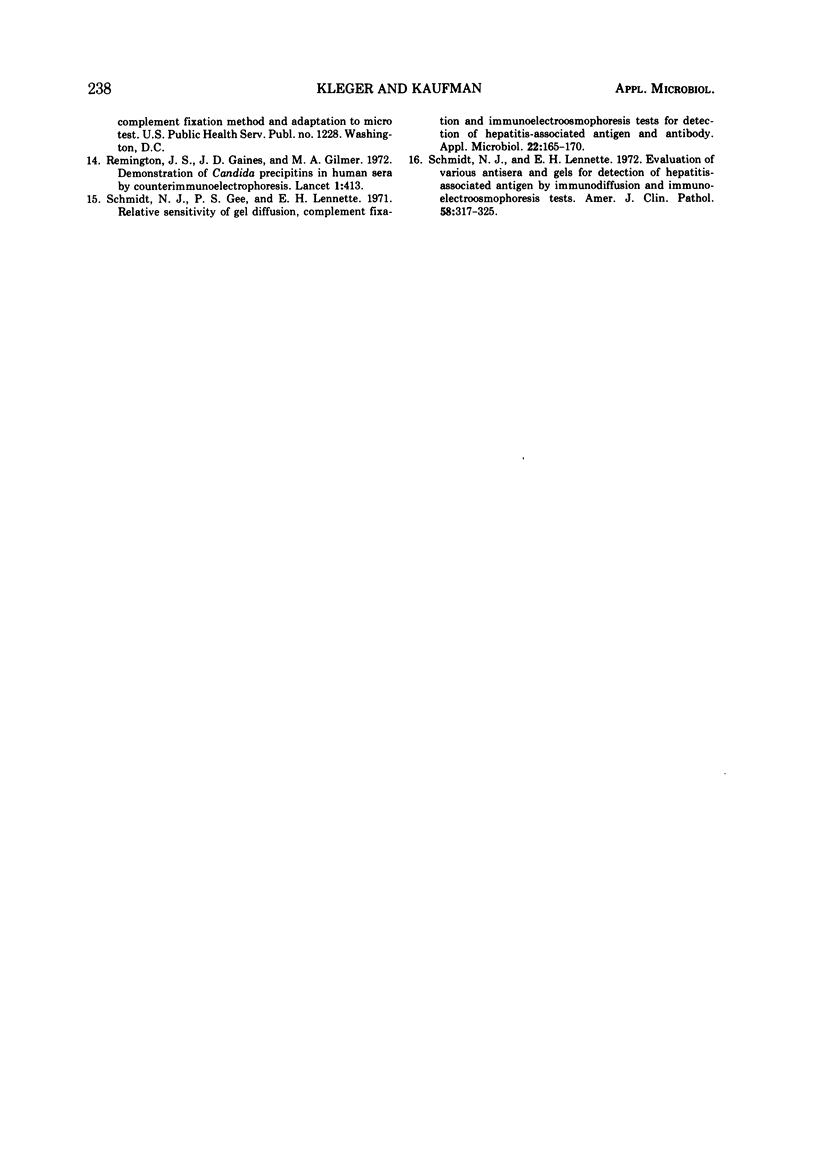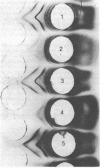Abstract
Studies were carried out to develop and evaluate a counterelectrophoresis (CEP) technique for the rapid and specific identification of the diagnostically important histoplasmosis H and M precipitin bands. Well-defined and centrally located precipitin bands were produced by using a discontinuous buffer system and a gel matrix composed of agarose and ionagar no. 2. A template was devised which allowed the selective identification of the H and M precipitins. Comparative evaluations were performed with the microimmunodiffusion (ID) and complement fixation tests. In 52 sera from persons with histoplasmosis, either the H or M precipitin, or both, were identified in 42 (81%) of the cases with the CEP technique and in 43 (83%) with the ID test. With sera from 28 persons with heterologous diseases, the CEP technique, like the ID test, failed to react. The specificity of the CEP technique was dependent upon the use of the identity template. The CEP technique is recommended for routine use in laboratories testing moderate numbers of sera. It provides accurate and reproducible results within 90 min, in contrast to the ID test, which requires 18 to 24 h.
Full text
PDF







Images in this article
Selected References
These references are in PubMed. This may not be the complete list of references from this article.
- Alter H. J., Holland P. V., Purcell R. H. Counterelectrophoresis for detection of hepatitis--associated antigen: methodology and comparison with gel diffusion and complement fixation. J Lab Clin Med. 1971 Jun;77(6):1000–1010. [PubMed] [Google Scholar]
- Edwards E. A., Muehl P. M., Peckinpaugh R. O. Diagnosis of bacterial meningitis by counterimmunoelectrophoresis. J Lab Clin Med. 1972 Sep;80(3):449–454. [PubMed] [Google Scholar]
- Gocke D. J., Howe C. Rapid detection of Australia antigen by counterimmunoelectrophoresis. J Immunol. 1970 Apr;104(4):1031–1034. [PubMed] [Google Scholar]
- Gordon M. A., Almy R. E., Greene C. H., Fenton J. W., 2nd Diagnostic mycoserology by immunoelectroosmophoresis: a general, rapid, and sensitive microtechnic. Am J Clin Pathol. 1971 Oct;56(4):471–474. doi: 10.1093/ajcp/56.4.471. [DOI] [PubMed] [Google Scholar]
- Greenwood B. M., Whittle H. C., Dominic-Rajkovic O. Counter-current immunoelectrophoresis in the diagnosis of meningococcal infections. Lancet. 1971 Sep 4;2(7723):519–521. doi: 10.1016/s0140-6736(71)90439-9. [DOI] [PubMed] [Google Scholar]
- HEINER D. C. Diagnosis of histoplasmosis using precipitin reactions in agargel. Pediatrics. 1958 Oct;22(4 Pt 1):616–627. [PubMed] [Google Scholar]
- Holper J. C., Jambazian A. Comparative sensitivity of complement fixation, counterimmunoelectrophoresis, radial, and double diffusion for detection of Australia antigen. Transfusion. 1971 May-Jun;11(3):157–161. doi: 10.1111/j.1537-2995.1971.tb04395.x. [DOI] [PubMed] [Google Scholar]
- Jameson J. E. Rapid and sensitive precipitin test for the diagnosis of farmer's lung using immunoosmophoresis. J Clin Pathol. 1968 May;21(3):376–382. doi: 10.1136/jcp.21.3.376. [DOI] [PMC free article] [PubMed] [Google Scholar]
- Prince A. M., Burke K. Serum hepatitis antigen (SH): rapid detection by high voltage immunoelectroosmophoresis. Science. 1970 Aug 7;169(3945):593–595. doi: 10.1126/science.169.3945.593. [DOI] [PubMed] [Google Scholar]
- Remington J. S., Gaines J. D., Gilmer M. A. Demonstration of Candida precipitins in human sera by counterimmunoelectrophoresis. Lancet. 1972 Feb 19;1(7747):413–413. doi: 10.1016/s0140-6736(72)90860-4. [DOI] [PubMed] [Google Scholar]
- Schmidt N. J., Gee P. S., Lennette E. H. Relative sensitivity of gel diffusion, complement fixation, and immunoelectroosmophoresis tests for detection of hepatitis-associated antigen and antibody. Appl Microbiol. 1971 Aug;22(2):165–170. doi: 10.1128/am.22.2.165-170.1971. [DOI] [PMC free article] [PubMed] [Google Scholar]
- Schmidt N. J., Lennette E. H. Evaluation of various antisera and gels for detection of hepatitis-associated antigen by immunodiffusion and immunoelectroosmophoresis tests. Am J Clin Pathol. 1972 Sep;58(3):317–325. doi: 10.1093/ajcp/58.3.317. [DOI] [PubMed] [Google Scholar]






